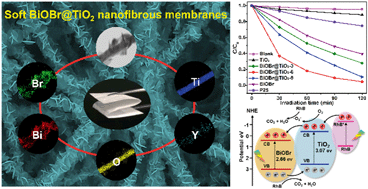Soft BiOBr@TiO2 nanofibrous membranes with hierarchical heterostructures as efficient and recyclable visible-light photocatalysts†
Abstract
TiO2-based heterojunction fibrous membranes with stable hierarchical nanostructures, excellent visible-light-driven photocatalytic activity, and easy-recycling ability would hold great promise in environmental remediation; however, it still remains a great challenge to construct such fantastic fibrous membranes. Herein, soft and hierarchical heterostructured BiOBr-anchored TiO2 nanofibrous membranes (BiOBr@TiO2 NFM) were fabricated by the sol–gel electrospinning technique combined with a facile successive ionic layer adsorption and reaction (SILAR) process. The well-crystallized BiOBr nanoplates with lamellar structure were uniformly grown onto TiO2 nanofibers, and the size and amount of BiOBr nanostructures could be finely regulated through rationally adjusting the growth cycles of SILAR. Benefiting from the large surface area, enhanced visible-light response, and intimately connected interfacial heterojunctions, the resultant membranes exhibited superior photocatalytic performance for rhodamine B (RhB) degradation under visible light irradiation, including a high degradation efficiency of 95.5% within 120 min and excellent reusability in 5 cycles. More importantly, the membranes still maintained good mechanical flexibility and structural integrity after utilization and could be directly extracted from solution. This study may provide a new strategy for the design and fabrication of soft hierarchical nanostructured TiO2-based fibrous membranes for environmental remediation and other potential applications.



 Please wait while we load your content...
Please wait while we load your content...